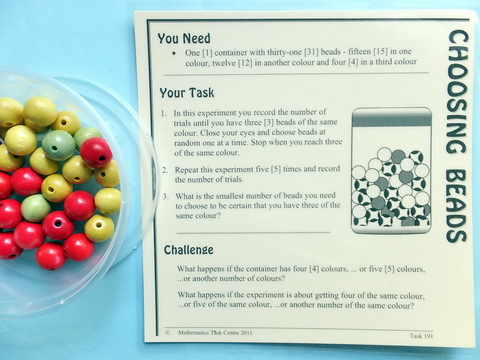
Choosing BeadsTask 191 ... Years 4 - 10SummaryThe task offers experience of sampling a mixed 'population' without replacement. The initial challenge is:What is the smallest number of beads you must select to be certain of having 3 the same colour?The card leads into an empirical beginning to the task. With eyes closed, students choose a bead, check its colour, choose again, check the colours and so on until three are the same colour. Students may need to do more experiments than the five suggested before they begin to find the keys to the problem. |
Materials
Content
|

IcebergA task is the tip of a learning iceberg. There is always more to a task than is recorded on the card. |
Students begin by experimenting. As they do so, it may begin to occur to them that the chances of getting each colour is not what matters in this problem. Rather, what matters is the number already the same after each selection. Clearly choosing 3 beads is not enough. The three might be the same but we can't be certain that they will be. It is reasonably natural to begin an analysis like this: Selection 1So the smallest number of beads that would have to be selected to be certain of three the same is 7. Did any of the students' trials take more than 7 beads? A follow up question that might be explored at this point is:
|
Whole Class InvestigationTasks are an invitation for two students to work like a mathematician. Tasks can also be modified to become whole class investigations which model how a mathematician works. |
It's worth checking with the art teacher for beads, but if you don't have them in the school use wooden or plastic cubes or linking cubes of uniform size. The bag doesn't need to be opaque, so a freezer bag will do. Seat the students in groups of four and provide a tub of mixed colours. Teams first make their bag according in the ratio you write on the board. Then remove the tubs until the challenge questions require changing the composition of the bag. You could use a story shell such as a factory that makes up bags of beads, but why not one about a factory that makes up specialty chocolates in three flavours. They don't put the same number of chocolates in each pack because it is more expensive to make certain fancy chocolates than it is to make plain ones. It's not hard to add a line that leads into the problem... In my family we share out the chocolates with our eyes closed, otherwise all the special ones would be taken. One day my daughter asked, I wonder how many times I would have to dip into the bag before I get three of the same chocolates?. There was only one way to find out.Now that the initial challenge is in place, encourage the teams to plan how they will experiment together. They might assign roles such as recorder, chooser, questioner and checker. Work the initial challenge as a class until the method of analysis is understood. Then discuss the possible What happens if...? questions. Allow each group to choose its own investigation from here and expect them to plan, execute and publish a report in some form. At this stage, Choosing Beads does not have a matching lesson on Maths300. |
Is it in Maths With Attitude?Maths With Attitude is a set of hands-on learning kits available from Years 3-10 which structure the use of tasks and whole class investigations into a week by week planner. |
The Choosing Beads task is an integral part of:
|